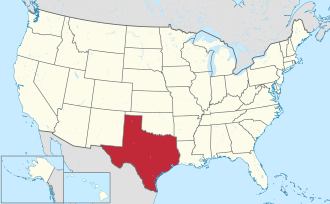History
The county was established by the state legislature on March 13, 1874, and named after Thomas Green, a Texas revolutionary and a Confederate brigadier general. It originally comprised an area over 60,000 sq mi (160,000 km2).
The original county seat was the town of Ben Ficklin. In 1882, flood waters of the Concho River destroyed the town and drowned 65 people. The county seat was moved to Santa Angela. In 1883, the town's name was officially changed to San Angelo by the United States Post Office. Following completion of the Santa Fe Railway in September 1888, the county increased its cattle production to an estimated export of 3,500 to 5,000 railroad cars. In 1889, San Angelo became incorporated to a city, and Fort Concho shut down after 22 years of operation. [4]
Tom Green County has a long, narrow strip of land extending to the west. This unusual feature is because Reagan County to the west used to be part of Tom Green County, and the state of Texas required that all counties have a contiguous land route to their county seat. The small strip of land served to connect the two main regions. In 1903, the residents of the western section voted to form Reagan County, while the same vote decided that the connecting strip would remain part of Tom Green County. [5]
In 2021, during Winter Storm Uri, the city of San Angelo endured 152 hours at or below freezing temperatures. [6] Hurricanes and tropical storms that have hit Tom Green include:
Demographics
Historical population| Census | Pop. | Note | %± |
|---|
| 1880 | 3,615 | | — |
|---|
| 1890 | 5,152 | | 42.5% |
|---|
| 1900 | 6,804 | | 32.1% |
|---|
| 1910 | 17,882 | | 162.8% |
|---|
| 1920 | 15,210 | | −14.9% |
|---|
| 1930 | 36,033 | | 136.9% |
|---|
| 1940 | 39,302 | | 9.1% |
|---|
| 1950 | 58,929 | | 49.9% |
|---|
| 1960 | 64,630 | | 9.7% |
|---|
| 1970 | 71,047 | | 9.9% |
|---|
| 1980 | 84,784 | | 19.3% |
|---|
| 1990 | 98,458 | | 16.1% |
|---|
| 2000 | 104,010 | | 5.6% |
|---|
| 2010 | 110,224 | | 6.0% |
|---|
| 2020 | 120,003 | | 8.9% |
|---|
|
Tom Green County, Texas – Racial and ethnic composition
Note: the US Census treats Hispanic/Latino as an ethnic category. This table excludes Latinos from the racial categories and assigns them to a separate category. Hispanics/Latinos may be of any race.| Race / Ethnicity (NH = Non-Hispanic) | Pop 2000 [12] | Pop 2010 [10] | Pop 2020 [11] | % 2000 | % 2010 | % 2020 |
|---|
| White alone (NH) | 65,508 | 63,799 | 62,390 | 62.98% | 57.88% | 51.99% |
| Black or African American alone (NH) | 4,122 | 3,997 | 4,010 | 3.96% | 3.63% | 3.34% |
| Native American or Alaska Native alone (NH) | 380 | 406 | 366 | 0.37% | 0.37% | 0.30% |
| Asian alone (NH) | 855 | 1,046 | 1,704 | 0.82% | 0.95% | 1.42% |
| Pacific Islander alone (NH) | 53 | 78 | 143 | 0.05% | 0.07% | 0.12% |
| Other Race alone (NH) | 88 | 129 | 369 | 0.08% | 0.12% | 0.31% |
| Mixed Race or Multiracial (NH) | 1,058 | 1,454 | 3,955 | 1.02% | 1.32% | 3.30% |
| Hispanic or Latino (any race) | 31,946 | 39,315 | 47,066 | 30.71% | 35.67% | 39.22% |
| Total | 104,010 | 110,224 | 120,003 | 100.00% | 100.00% | 100.00% |
As of the census [13] of 2000, 104,010 people, 39,503 households, and 26,783 families resided in the county. The population density was 68 people/sq mi (26 people/km2). The 43,916 housing units averaged 29 units per square mile (11 units/km2). The racial makeup of the county was 50.76% White, 5.13% African American, 0.65% Native American, 0.86% Asian, 0.07% Pacific Islander, 12.82% from other races, and 2.39% from two or more races. About 30.71% of the population were Hispanic or Latino of any race, 13.2% were of German, 10.7% American, 8.2% English, and 7.2% Irish ancestry according to Census 2000.
Of the 39,503 households, 33.00% had children under the age of 18 living with them, 52.10% were married couples living together, 11.90% had a female householder with no husband present, and 32.20% were not families. About 27.2% of all households were made up of individuals, and 10.80% had someone living alone who was 65 or older. The average household size was 2.52, and the average family size was 3.09.
In the county, the age distribution was 26.10% under 18, 12.80% from 18 to 24, 27.10% from 25 to 44, 20.60% from 45 to 64, and 13.40% who were 65 or older. The median age was 34 years. For every 100 females, there were 93.70 males. For every 100 females age 18 and over, there were 89.90 males.
The median income for a household in the county was $33,148, and for a family was $39,482. Males had a median income of $27,949 versus $20,683 for females. The per capita income for the county was $17,325. About 11.20% of families and 15.20% of the population were below the poverty line, including 20.20% of those under age 18 and 11.80% of those age 65 or over.
This page is based on this
Wikipedia article Text is available under the
CC BY-SA 4.0 license; additional terms may apply.
Images, videos and audio are available under their respective licenses.







